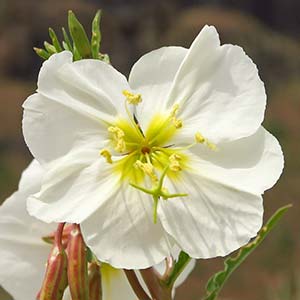Oenothera glaucifolia
Oenothera pallida
false gaura
mountain evening primrose, pale evening-primrose, rockweed brush, white-stem evening primrose
erect, branched or unbranched, 30–300 cm.
erect or ascending, single to several from base, unbranched or many-branched throughout, 10–50(–70) cm.
in a basal rosette and cauline, basal 3–7 × 0.5–2 cm, sessile, blade oblong to oblong-lanceolate, base usually ± auriculate, margins entire;
cauline 3–8(–10) × 0.4–1.8 cm, blade lanceolate to oblong-lanceolate, gradually smaller, becoming linear-subulate distally.
cauline, rosette usually weakly developed or absent, at least during flowering, sometimes well developed, 1–5(–7.8) × 0.3–1(–1.5) cm;
petiole 0–2(–4.5) cm;
blade lanceolate, oblong, linear-lanceolate, or ovate, margins subentire or remotely denticulate, deeply sinuate-dentate, or pinnatifid, sometimes repand.
long, wandlike, unbranched or branched.
4-merous, nearly actinomorphic, opening near sunrise;
floral tube 6–17 mm;
sepals 4–6 mm;
petals white, fading off-white or tinged pink, slightly unequal, rhombic, 4–6 mm, abruptly clawed;
filaments 5–8 mm, anthers 1.5–2 mm, pollen 85–100% fertile;
style 6–10, stigma exserted beyond anthers at anthesis.
1–several opening per day near sunset;
buds nodding, weakly quadrangular, with free tips 0–2 mm;
floral tube 15–40 mm;
sepals 10–30 mm, not spotted;
petals white, fading pink to deep pink, broadly obovate or obcordate, (10–)15–25(–40) mm;
filaments 9–15 mm, anthers 3–10 mm;
style 25–55 mm, stigma exserted beyond anthers at anthesis.
ovoid, 4-angled, somewhat flattened, 3–4 × 1.5–2.3 mm, valves with raised midrib and conspicuous lateral veins;
sessile.
spreading to reflexed, straight to curved or contorted, cylindrical, obtusely 4-angled, tapering slightly from base to apex, 15–60 × 1.5–2.5 mm;
sessile.
1, pale yellow, oblanceoloid, 2.4–2.6 × 1–1.5 mm.
numerous, in 1 row per locule, brownish with dark spots or black, narrowly obovoid, 1.5–2.2 mm.
= 14.
Oenothera glaucifolia
Oenothera pallida
Oenothera glaucifolia is self-incompatible, the flowers diurnal, pollinated primarily by wasps (R. Clinebell, unpubl.), as well as bees, flies, butterflies, and occasionally beetles (summarized by W. L. Wagner et al. 2007). It was collected once in 1988 in Indiana at Miller Woods Visitor Center (Lake County), Dritz 596 (MOR); it seems likely that it was introduced, and has not been collected there since.
Stenosiphon virgatus Spach is a superfluous name and pertains here.
(Discussion copyrighted by Flora of North America; reprinted with permission.)
Subspecies 4 (4 in the flora).
Oenothera pallida is a poorly understood species currently subdivided into four subspecies (W. L. Wagner et al. 2007) that differ largely in aspect, leaf division, capsule configuration, and pubescence. The variation pattern is rather complex with almost no diagnostic character uniformly distinguishing any one of the subspecies. Instead, each of the subspecies, which are mostly geographically separated although there is some level of overlap, have diagnostic suites of characters that maintain their linkage some of the time, but break down across the geographic area of each so that no single character uniquely identifies it. Each subspecies is characterized by leaf, pubescence, and, often, habit features. The issues with the integrity and intergradations of the subspecies are discussed below.
Oenothera pallida has been determined to be self-incompatible (W. L. Wagner et al. 2007), but K. E. Theiss et al. (2010) determined that although most populations of subsp. pallida are self-incompatible, one near Salt Lake City is self-compatible.
(Discussion copyrighted by Flora of North America; reprinted with permission.)
1. Herbs annual, sometimes perennial from a taproot, when perennial, sometimes with lateral roots producing adventitious shoots, strigillose throughout and villous distally, especially on flower parts. | subsp. trichocalyx |
1. Herbs perennial from a taproot and with lateral roots producing adventitious shoots, glabrous, strigillose, or sparsely villous. | → 2 |
2. Plants glabrous, sometimes strigillose, rarely sparsely villous; leaf blade margins usually subentire or remotely denticulate, rarely pinnatifid; capsules usually contorted to curved. | subsp. pallida |
2. Plants usually strigillose, rarely villous or glabrous; leaf blade margins shallowly sinuate-dentate or denticulate, or deeply sinuate-dentate to pinnatifid, rarely only dentate; capsules usually straight or curved, sometimes contorted. | → 3 |
3. Leaf blades (0.4–)0.7–1.5 cm wide, margins shallowly sinuate-dentate or denticulate. | subsp. latifolia |
3. Leaf blades 0.4–1(–1.5) cm wide, margins usually deeply sinuate-dentate to pinnatifid, rarely dentate only. | subsp. runcinata |


